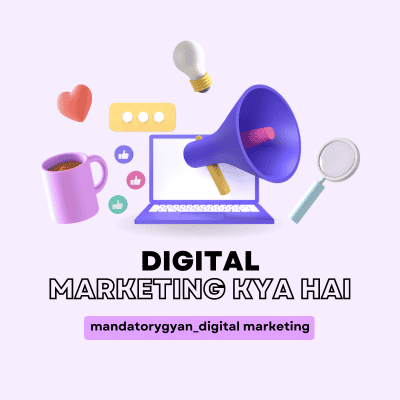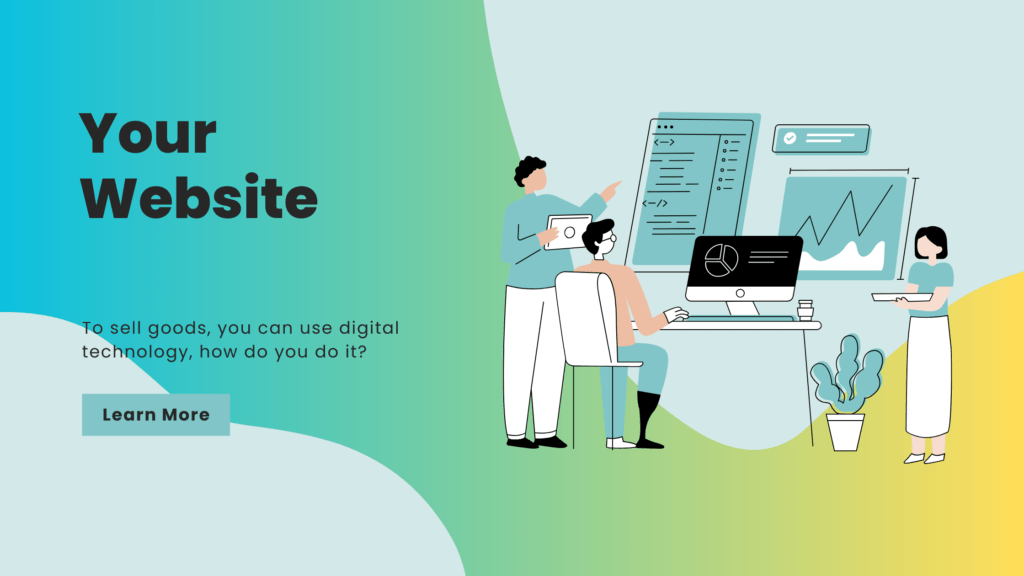
“Hey, guys! How’s everyone?
I’ve been talking to you about digital marketing for a while. You know, why it’s good, how to use it, and all that jazz about stuff.
I’m also going to show you how digital marketing can help your business grow and make more money.
We’ve talked about how to use digital marketing in your business and how you can make money by becoming good at it.
I have been telling you all these things through post, YouTube videos, blogs and social media plate forms.
But what if you could get all that information in one place, instead of traveling to different places and times?
I think when you want to learn about digital marketing, it will make you very happy and will also save your time.
It’s like a big guide that explains all the parts of digital marketing.
So, let’s get started with this amazing guide. What else? It’s completely free!”
Digital Marketing Kya hai – What is Digital Marketing?

“Digital Marketing is an art that allows you to promote your products and services online, reaching people anywhere in the world.
The benefits of digital marketing, such as reaching customers easily and quickly, understanding their needs, addressing their problems, and customizing products, contribute to its continuous growth.
Digital marketing involves using platforms like social media, apps, websites, and email marketing to sell products and services. But what specific digital marketing tactics can help take your offline business online and sell your products? Let’s explore that in the next section.”
Level of Digital Marketing / Digital Marketing Components / Digital Marketing Strategies
“Using strategies to establish an online presence and sell products is called a digital marketing.”
Let’s focus on 8 of the best digital marketing
- Content Marketing
- Search Engine Marketing (SEM)
- Social Media Marketing (SMM)
- Search Engine Optimization (SEO)
- Pay Per Click Advertisement (PPC Ads)
- Affiliate Marketing
- Email Marketing
- WhatsApp’s Marketing

Content Marketing
Content marketing means creating and promoting content on various digital platforms!
According to HubSpot, about 85% of marketers actively use content marketing, which gives you an idea of how popular it is.
This is used to build a digital presence, create brand awareness, increase website traffic, and generate leads.
As you start creating content, people get to know you, your brand becomes more recognized, and you begin attracting your target audience to your online platforms.
Content marketing involves using various channels, known as content marketing channels, to create content that is then promoted through other digital marketing strategies.
Examples of content include blog posts, audio and video content, newsletters, e-books, and more.”
Social Media Marketing (SMM)
The sole purpose of social media marketing is to reach your target audience. Once the audience starts engaging on social platforms, they are offered quality products or services, resulting in earnings.
Social media marketing strategies often include the use of paid tactics, and viral campaigns are run on platforms like Facebook, Instagram, LinkedIn, Twitter, Snapchat, and more.
Search Engine Marketing (SEM)
This strategy is a paid approach, unlike Search Engine Optimization (SEO).
Under this approach, advertisements are run on search engines like Google and Bing. The goal behind running these ads is to bring as many people as possible to your online platform.
To run these ads, suitable keywords are targeted. Alternatively, you can also say that ads are specifically run for certain keywords.
Whenever someone searches their queries on search engines using these keywords, your website appears before them, and this way, you continue to receive traffic.
Search Engine Optimization (SEO)
SEO is a technique used to rank a website on a search engine organically, without spending money. Similarly, YouTube SEO is used to rank YouTube videos on YouTube.
In SEO, the selection of the right keywords is the most crucial factor and plays a significant role in ranking a website.
If we talk about the various aspects of SEO, it can be divided into four parts – On-Page SEO, Off-Page SEO, Technical SEO, and Local SEO.
Under On-Page SEO, web pages are optimized according to Google algorithms.
Off-Page SEO includes activities that are not directly related to your website but are still responsible for ranking, such as backlinks and directory submissions.
Technical SEO involves optimizing your website in a way that it can be easily indexed and crawled by search engine crawlers.
In Local SEO, your website is optimized for local business, making it accessible to the audience in your local area, allowing them to transact with your business
Pay Per Click Advertisement (PPC Ads)
PPC advertising is a method of generating traffic where you pay the publisher whenever someone clicks on your ad.
PPC ad campaigns are run to attract the target audience and direct them to your website.
One of the most commonly used PPC ad campaigns is Google Ads.
Affiliate Marketing
This is a method where you earn money without creating your own products or services.
In this method, you affiliate with a merchant or affiliate program and promote products related to your niche to people.
To promote them, you use affiliate links provided by these merchants, which you place on your affiliate sources.
When someone clicks on these affiliate links and purchases the affiliate products, you receive a commission as earnings.
The affiliate marketing industry is gradually becoming quite popular
Email Marketing
Email marketing serves as a communication channel that facilitates communication between two individuals.
Through this technique, various tasks such as content promotion, offering discounts, scheduling webinars, planning events, and cold pitching are accomplished. Digital marketers often run email marketing campaigns to sell their products or services and direct traffic to relevant websites or platforms
Apps Marketing
The technique of reaching people with content, products, and services through the creation of mobile applications is referred to as app marketing.
In today’s world, with the widespread use of smartphones and internet access, app marketing has become an easy way to advertise and sell products.
We’ve discussed various digital marketing tactics, but you might be wondering why we need them in the first place. What does digital marketing offer that traditional marketing cannot?
To answer these questions and understand the advantages of digital marketing, we need to explore its strengths
WhatsApp Marketing
WhatsApp marketing is like using WhatsApp to connect with customers and promote your business. Instead of just chatting with friends, businesses can send messages, offers, and updates to their customers through WhatsApp. It’s a way to stay in touch with your audience and keep them informed about your products or services. You can also provide customer support and answer questions through WhatsApp, making it a versatile tool for businesses to engage with their customers directly on a platform they already use every day
Importance of Digital Marketing – Digital Marketing
Advantages

Digital Marketing is emerging as an industry that’s attracting millions of people and providing employment opportunities. Business owners are implementing it to boost their sales. Let’s discuss the benefits of Digital Marketing and why it’s becoming so popular
- Increase Online Presence: To sell anything online, you need to establish your presence. Digital Marketing helps you do this by creating a presence on websites, YouTube, and social media channels.
- Ability To Reach & Target the Right People: Digital Marketing allows you to reach people in other countries and target specific audiences interested in your niche
- Ability To Interact & Communicate With Prospects: You can constantly communicate and interact with your prospects, building trust through content, email marketing, social media, and videos
- You Get to Know User Navigation: You can track the activities of users on your online sources, learning where they click, what they’re looking for, and how to provide it
- Cost-Effective: Even with a low budget, you can implement Digital Marketing in your business. It’s an excellent option for startups and new businesses to create brand awareness.
Can be Done From Anywhere in the World: You can implement Digital Marketing from any location, even without physical office space
How to Build a Digital Ecosystem?
The best way to learn any skill is to apply it practically. Practical application helps you understand things quickly and clears any doubts in your mind. Similarly, after learning Digital Marketing, it’s essential to practice it to create your Digital Ecosystem
To learn and create your Digital Ecosystem, follow these steps:
- Select Your Niche
The first step in starting any business is selecting a niche.
You may not be perfect in all fields, but you can have expertise in a specific area.
Choose your niche based on your passion, interests, solving people’s problems, niche potential, etc.
Build Your Website
After choosing your niche, you need to create a website for content creation.
To build a website, you’ll need a domain and hosting, giving your business a name.
You can use a free platform like Blogger.com, which doesn’t require purchasing a domain and hosting. However, Blogger.com is suitable for practice, not for long-term use.
If you plan to run your website long-term and want to build credibility, use WordPress. WordPress allows you to install plugins, customize themes, and make your website look better.
- Create Profiles on Social Media Platforms
Just creating a website won’t suffice; you need to create profiles on various social media platforms.
After creating profiles on major platforms like YouTube, Facebook, Instagram, LinkedIn, Twitter, you can move on to the next step.
Optimize Your Social Media Platforms
Once you’ve created profiles, it’s time to optimize your social media platforms.
Your profile picture, description, color theme, etc., should be consistent across all your platforms.
You should also tailor your content to suit the different social media platforms based on what works best.
- Create & Publish Content
In the final step of building your Digital Ecosystem, you need to produce content that is attractive, engaging, SEO-friendly, and potentially viral.
You will create content for your website and share it on various platforms like YouTube, Facebook, Instagram, LinkedIn, Twitter, Quora, etc.
A Website – An Essential Digital Asset for Any Business
A website serves as a crucial digital asset for any business, whether it’s small or large. Without a website, a business remains incomplete.
All online businesses formulate numerous strategies for traffic and leads generation. However, when implementing these strategies and driving traffic, there is a need for a platform that can introduce visitors to products and services.
To fill this role, there is no better option than a website. Let’s delve deeper into what a website is, its significance, and how it is designed

What is a Website – Understanding the Concept?
A website is a digital asset for any business that showcases its identity. It provides people with insights into what a company does, what kinds of products or services it offers, its policies, its customer base, and many other details.
Technically speaking, a website is a collection of various web pages, all under one domain, hosted on a server. You bring visitors to your website through various marketing strategies, where you inform them about your products or services.
Therefore, it’s crucial to always make your website responsive, attractive, and mobile-friendly, ensuring that if visitors arrive, they’ll spend some time exploring it
The Importance of Having a Website
In today’s digital age, having a website is crucial for all businesses, whether they operate online or offline. Let’s explore why having a website is so essential and the benefits it brings:
Professional Image: A website showcases your professional side, helping people understand your business. Studies show that 75% of consumers judge a company’s credibility based on its website. So, having a professional and responsive website boosts your credibility. If you want to work professionally, having a business website is a must. It allows you to share your business details separately from your personal life, such as your education, experience, team, clients, and completed projects.
Getting Traffic from Search Engines: To attract visitors, especially in online businesses, using search engines is vital. Almost all information is available on Google, so you’d want people to discover your information, products, and services. Therefore, if you want to attract traffic without spending money, Search Engine Optimization (SEO) is a great method. By using the right keywords and SEO techniques, you can rank your website on Google and draw organic traffic.
Showcasing Products & Services: A website is an excellent platform to display your products and services. When visitors land on your website, they can easily see what you offer. You can use high-quality images, videos, and infographics to present detailed information about your products and other essential details.
Boosting ROI: Creating a website involves affordable investments like domain and hosting. This investment provides a powerful platform that can attract numerous visitors for free, potentially increasing your revenue significantly. Additionally, if you want quick results, you can use ad campaigns to reach your target audience and make transactions. This makes a website a cost-effective, high-return-on-investment platform.
Always Active: A website acts as a marketing platform that works around the clock, every day of the year. It allows you to stay active without the need for physical office space or constant hiring, making your business accessible to customers at all times.
AVE MY VISITING CARD LINK AND GET BEST DEALS ON LIKE – FLIPKART |JIO MART | CREDIT CARD | PERSONAL LOAN | INSTA LOAN | FOLLOW MY CHANNEL UPCOMING VIDOES| WOULD REQUEST YOU TO PLEASE SHARE MY VISITING CARD TO YOUR WHATSAPP GROUP TO GRAB OFFER AND HAPPY TO ASSIST THEM (About )









[…] polls also give us information about the voters in the so-called swing states. These states define who of the candidates will […]